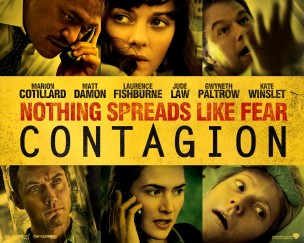
Lately I’ve been coming down with a bit of a cold–sneezing, runny nose, fatigue, etc. Generally, nothing to worry about, right? Too bad the onset of my illness coincided with my viewing of “Contagion” this weekend, a film that traces the consequences of a virus with the exact same initial symptoms that I have now found myself experiencing. Oh, and it wipes out billions of people worldwide within a matter of 6 months.
“Contagion,” the latest from director Steven Soderbergh (of “Ocean’s Eleven” and “Erin Brockovich” fame), is a terrifyingly realistic examination of human fear. The film explores the spread of the virus across several different viewpoints, depicting in harrowing detail its impact on all different facets of life. It’s packed with acting heavyweights, starring Gwyneth Paltrow as the first woman to succumb to the virus, Matt Damon as her husband, Kate Winslet as a Center for Disease Control doctor and Laurence Fishburne as her boss, Marion Cotillard as a World Health Organization epidemiologist, and Jude Law as a conspiracy-obsessed blogger. “Contagion” jumps between these diverse story lines to show the full devastation that the virus leaves in its wake.
“Contagion” is not a movie about viral infection; it’s a movie about fear and paranoia. As in “28 Days Later,” another film about a viral pandemic, human nature proves to be more detrimental than the virus itself. Relatively early in the film, Soderbergh stops dwelling on the ever-mounting death toll of the virus and moves into the psychological toll on the survivors. Chaos breaks down the social code that we all take for granted in our era of relative safety. In the richly detailed world of the film, survival is all.
The opening five minutes of the film are a brilliant exercise in the awesome and unparalleled power of film to convey fear. With limited dialogue, Soderbergh presents us with close-up after close-up of people touching objects, surfaces, and each other. As people drop dead, one can’t help but develop an extreme aversion to any form of contact, so a shot toward the middle of the film of a sick man’s hand grasping and then releasing a bus hand rail causes an overwhelming and uncomfortable feeling of dread. With great intelligence, Soderbergh easily solves the most difficult problem of the film: how do you arouse fear in an audience of an enemy that you never see, and is in fact undetectable by the human eye? Mission accomplished, as when I walked out of the movie theater I couldn’t help but notice just how much people touched everything in the world around them, and vowed to buy a jumbo-sized bottle of hand sanitizer.
The movie’s greatest strength is its hyper-realism. Given the recent panic over H1N1, the outbreak of a bat-pig hybrid virus isn’t difficult to imagine. Soderbergh takes his time explaining the scientific background of the virus so that its implications are fantastic enough to be terrifying but also sounds fully plausible. Futhermore, the acting and cinematography of the film are simple and grounded in realism. By giving us access to the diverse implications of the pandemic, from the scientific to the personal, Soderbergh fully immerses us in the world of the film, and we are just as desperate as the characters to know that a cure can be found before the entire population ends up dead.
However, that wide scope is also, in my opinion, a weakness of the film. All the characters are extremely compelling, but without one storyline to fully align with, it’s hard to really invest emotionally in the film. It’s definitely a cerebral film rather than a sentimental one. Thus, character deaths contribute to the mounting sense of fear and dread, but fail to resonate on a personal level. The closest any of the storylines come to real emotional connection is Matt Damon’s attempts to protect his daughter, impressively played by newcomer Anna Jacoby-Heron, from the horror around them, but our attention is given too much room to wander for us to really care about the individual fates of any character.
Yet by rendering the scenario so richly plausible, Soderbergh succeeds in creating a truly terrifying film. This is a new generation of disaster movie, free of heavy-handed special effects and melodramatic speeches, and that makes it all the scarier. With a new virus flaring up every flu season or so, who knows which one will end up killing us all?


Leave a Reply